In this section we will cover a variety of use cases in a generic manner to highlight best practice use cases of Kianda features and how they help solve specific requirements.
This is the multi-page printable view of this section. Click here to print.
Example Use Cases
- 1: Non-Conformance Report
- 2: Simple Inspection process
- 2.1: Request Form
- 2.2: Inspection Form
- 2.3: Dashboard
1 - Non-Conformance Report
In this example we will show how we can create a Nonconformance Process and step through the logic behind the rules and fields within each of the forms:
- a Nonconformity Details Form which is completed by a company employee, reporting a nonconformance within a company.
- an Auditor Review Form which will be completed by an Auditor that reviews the nonconformance and has the ability to create an action plan along with individual actions that will be sent via email to responsible employees.
- an Action Confirmation Form which will be completed by a supervisor within the company. This form is used to confirm that all actions from the auditor review form were completed.
- a Closure Form which is completed by a manager within the company. This form is used to select the outcome of the plan to resolve the nonconformance.
The result at the end of the process is an email to both the originator and a site manager, who receive a PDF report of the nonconformance.
The process will use utility panels to hold form fields and values, not visible to the end user, but these will be used with rules to automate the process.
You can download the process file which you will be able to import to your own subscription and examine the process in full detail. Click on the following link to download the .kianda file: Nonconformance Process
The following image is a step by step roadmap of our process:
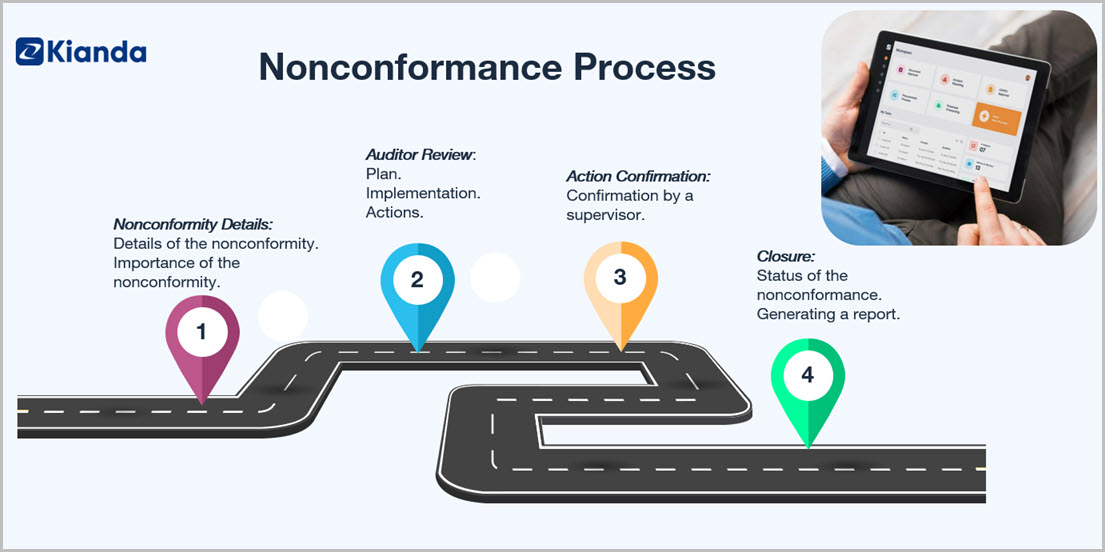
Introduction
Nonconformance introductory video going through the idea of the process and what can be done with it. We are also introducing staff that will help to understand the process and the workflow between users and its forms.
Non conformance details form
This section describes the purpose of the Nonconformance details form, and outlines the type of information that is captured. In this form we will focus our attention to an Assign form rule and a Send email rule. We will be using the send email rule across the process and therefore the logic behind implementing it will be the same. We will also focus on a Configuration panel that will be invisible to users. We will use the panel to store a template for our report and have a few fields that will help us when creating a name for the report. In combination with our Closure form, we will also take a quick look at the Kianda Word add-in to create a template for our report.
Auditor review
This section describes the purpose of the Auditor review form, and outlines the type of information that is captured. In this form we will focus our attention on individual actions that the Auditor can create to match his Plan and Implementation. We will use a Table and a Dialog fields as well as a Loop table rule to create the desired functionality.
Action confirmation
This section describes the purpose of the Action confirmation form, and outlines the type of information that is captured. In this form we will focus our attention on a Field group that allows us to mirror fields from different forms within our process and group them together. The Field group prevents us from re-creating fields as the values from the original field will be copied into the field inside of the field group.
Closure
This section describes the purpose of the Closure form, and outlines the type of information that is captured. In this form we will focus our attention on a Schedule a rule and a Generate word document rules. We will use those rules in combination with the resources from our Nonconformity details form and more specifically the template that is stored within a configuration panel.
Dashboard
Kianda dashboards deliver a convenient way to provide insights into how your business processes are performing. Kianda dashboards offer easy reporting, permissions management, quick build, condition-based filtering and many more features.
From lists to tiles, filter and charts, dashboards allow you to build full digital experiences to monitor your real-time processes in a few minutes. To learn more about dashboards go to Dashboard pages.
You can also examine how a dashboard was made for our Inspection process example by going to Simple Inspection process.
What’s next 
You can create a Dashboard page to show the status completion of the process.
This process is available as a downloadable .kianda file here.
2 - Simple Inspection process
In this example we will step through how to create a simple Inspection process made up of two forms:
- a Request form which is completed by a company employee, requesting an engineer to visit a specific location to perform an inspection
- an Inspection form which contains the inspection checklist that the engineer must complete
The result at the end of the process is an email to a designated Safety manager, who receives a PDF report of the inspection form.
The process will use utility panels to hold form fields and values, not visible to the end user, but these will be used with rules to automate the process.
The following image is a step by step roadmap of our process: 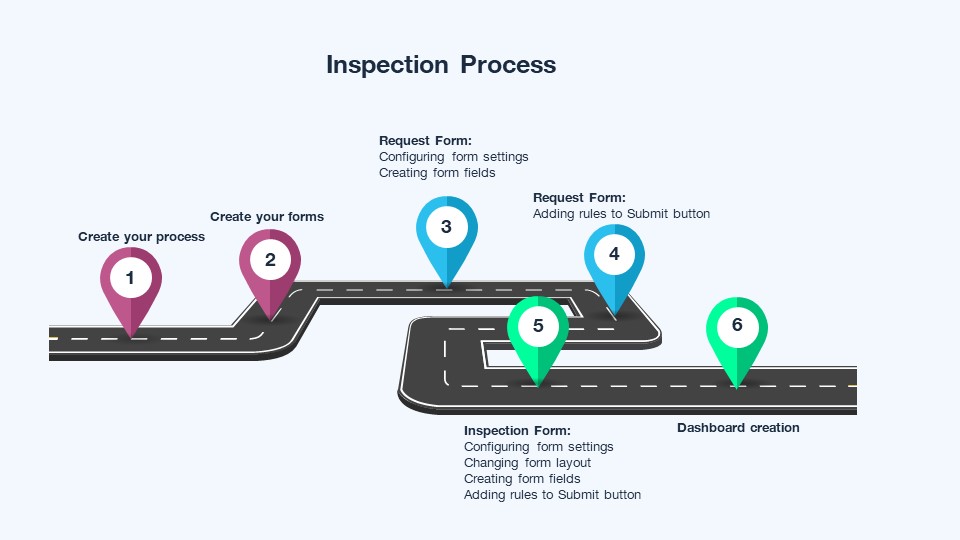
Creating a new process
You can create an Inspection process if you have the role Administrator or Designer by going to the left-hand side menu and click on Administration and Designer.
-
When you are in process designer window, click on Add new button to start a new process. This button can be found at the top of the screen.
-
Add new process window appears with the following fields to fill out:
- Title - represents the name of your process which is also the displayed name for other users.
- ID (unique) - A unique ID which is used to identify your process.
- Description - Piece of text to describe your new process.
- Group - A group which you want your new process to belong to.
- If a group already exist, it will simply add your new process to that group.
- If the group does not exist, it will make a folder for you and automatically add the process to that group.
- Administrators - In this field you can choose to add Users and Groups to be administrators of the new process. This field determines who can edit and make changes to your process.

-
After you fill out the information needed, press OK. You are automatically brought into a blank process creation page, which looks as follows:

Planning Form Requirements
In the example of the Inspection process we already discussed, we will need two forms: 1) Request form and 2) Inspection form. For our process, we need to make a list of requirements for the information we need to capture in each form. The information that will be provided to users in each form, for example a what company and location the inspection needs to be completed in. To learn more about planning process requirements, go to Planning your process.
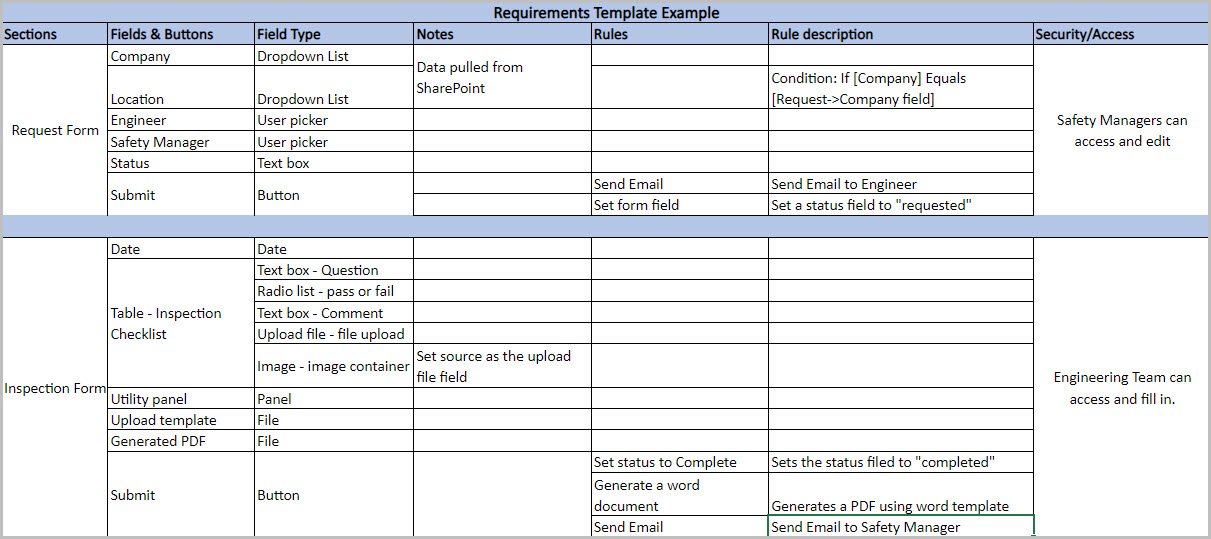
What’s next 
Now that we have a list of all our requirements for this process, we can continue on by creating our first form. To learn more on how to create the Request Form step by step, go to Creating Request Form.
2.1 - Request Form
Creating the Request Form
Configuring Form Settings
-
From the process creation page, click on form 1 to select the form. This can be found at the top of your screen.

-
Click on the edit or pen icon
 on the selected form to edit it.
on the selected form to edit it. -
An Edit form dialog box appears on your screen. There are 8 different fields to fill in.
- Title - Name to represent this form. In our case we will call it Request Form.
- Name (unique) - A unique identifier for our form. You can give this any name you would like as long as it’s unique.
- Default owner(s) - This field identifies which users can fill out our form when it’s complete. In our case we will choose from Groups and choose our Management Team. To learn more about how to create groups in Kianda go to creating groups.
- Activate with - Means that the form can be activated with other forms within the process, so they can be edited at the same time. This means several forms become the current form in a form group. In our case we will leave this blank.
- Submit mode - This option means that when a process instance is running you can choose only this form to be submitted, or you can choose all forms in edit mode meaning that several forms could have their details submitted or saved. Choose Only this form radio list.
- Form icon - Dropdown field to select an icon for the form.
- Form theme - This option is used to change the colour of the form tile, for example Green.
- Enable quick actions - if you tick the checkbox, you can select from the options a) Enable re-assign b) Enable edit and c) Enable custom action. We will leave this box unchecked.
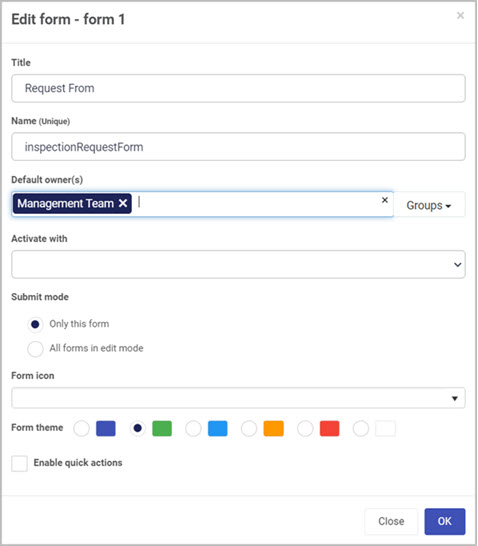
-
Click on the OK button when you are finished editing to save your changes or click on Close to exit the dialog box without saving.
-
To save your changes to the form, click on the Save button

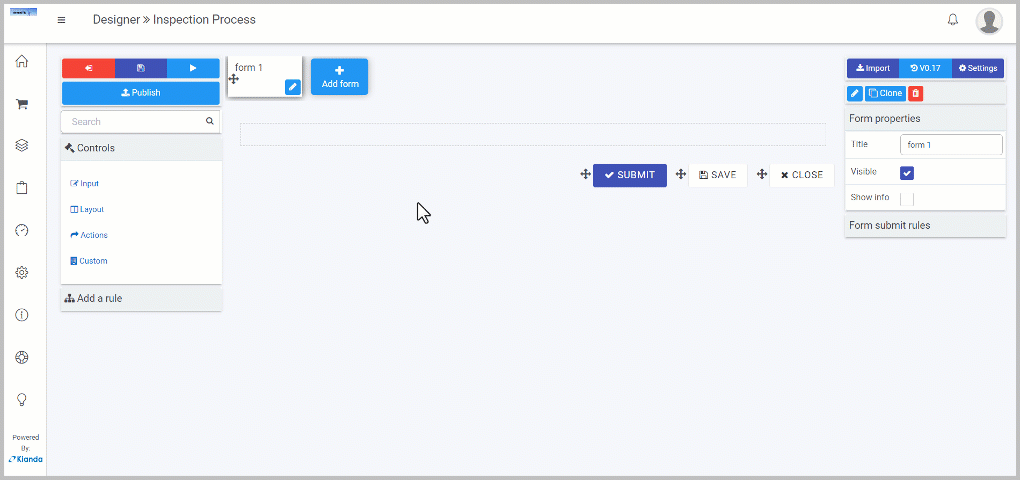
Creating Form Fields
On the Request form there is 5 different fields which will be used to make a request for an inspection:
- Company - Which company we need the inspection to be completed in.
- Location - What location of that company we need to go to.
- Engineer - Assign an engineer to complete the inspection.
- Safety Manager - Assign a safety manager which will receive a completed Inspection form.
- Status - Field representing the status of the process. For example the status can be Requested or Completed.
Creating a List field- Company
The Company field represents the company we want our inspection to take place at. It is a List input which is populated from our SharePoint datasource. To learn more about List input, go to List Control.
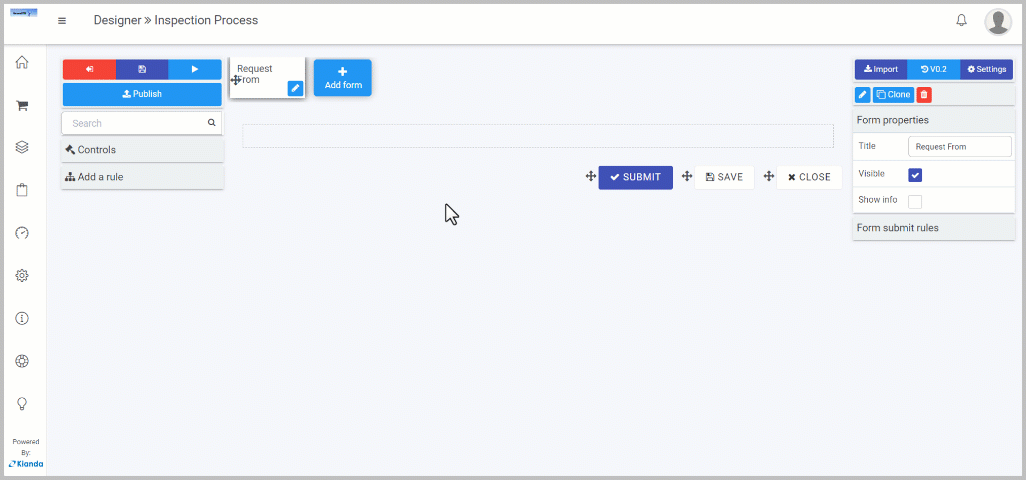
-
Click on Controls in the left-hand pane to expand the Controls menu.
-
Select Input to view the range of Input controls.
-
Click on List.
-
A New field - List dialog box will open with a range of options you can choose from for your new List field.
-
Change the Title to “Company”.
-
Change the Name (unique) to a unique identifier.
-
Select the Data source within the List source radio list.
-
Click on the Datasource
 button. This will open a data source selector dialog box. To learn more about adding a SharePoint data connector, go to Connecting to SharePoint.
button. This will open a data source selector dialog box. To learn more about adding a SharePoint data connector, go to Connecting to SharePoint. -
Click on your SharePoint connector and select Companies(the companies data should be pre-created in your SharePoint, see the image below for an example). Click on OK on the Datasource dialog box.
SharePoint Companies List
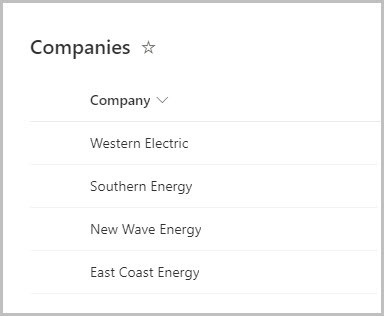
-
From the dropdown on the Display, Value and Sort by fields select Title.
-
Leave all of the other options as default. Click on **OK **in the Edit field dialog box.
Creating a List field- Location
The Location field represents the location of our inspection. This field is a cascading dropdown selection which corresponds to the Company field (see above). The goal is to display only the locations of the selected company. We will add a condition to this field, you can see how that’s done below. To learn more about cascading dropdown lists go to Cascading dropdown lists.
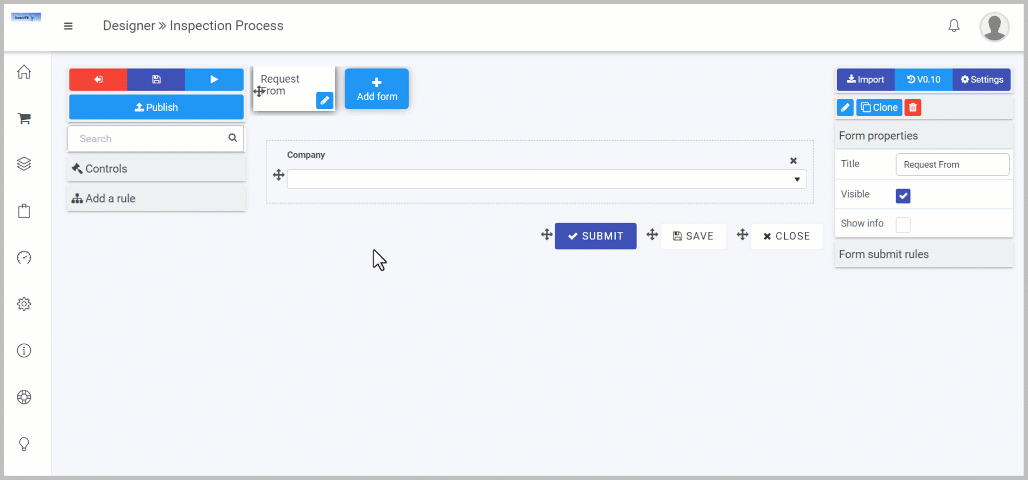
-
Click on Controls in the left-hand pane to expand the Controls menu.
-
Select Input to view the range of Input controls.
-
Click on List.
-
A field edit box will appear in which we change the Title to “Location”.
-
Change the Name (unique) to a unique identifier.
-
Select the Data source within the List source radio list.
-
Click on the datasource
 button. This will open a data source selector box.
button. This will open a data source selector box. -
Click on your SharePoint connector and select Location(the location data should be pre-created in your SharePoint, see the image below for an example). Click OK on the Datasource dialog box.
SharePoint Locations List

-
From the dropdown on the Display, Value and Sort by fields select Locations.
-
To create the cascading selection we add a condition. Click on Edit conditions

-
In the Edit condition dialog box, select Company in the first dropdown.
-
Select Equals in the second dropdown.
-
Select Company in the third dropdown.

-
Click on OK on Edit conditions dialog box.
-
Leave all of the other options as default. Click on OK in the Edit field dialog box.
Creating a User Picker field - Engineer
The Engineer field represents the engineer we want to complete the inspection. This field is a User picker field in which we can pick any of our Kianda users.
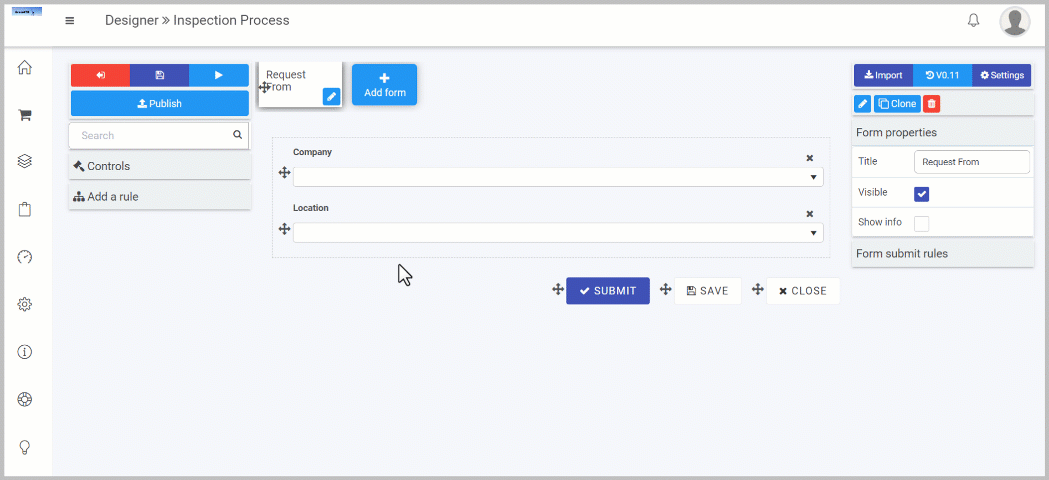
- Click on Controls in the left-hand pane to expand the Controls menu.
- Select Input to view the range of Input controls.
- Click on User picker.
- In the Edit field box change the Title to “Engineer”.
- Change the Name (unique) to a unique identifier.
- Click on OK
 to save.
to save.
Cloning a User Picker field - Safety Manager
The Safety Manager field represents the manager which requests the inspection. This is a User picker field just like the above Engineer. We will go through how to clone a field and add it into our form.
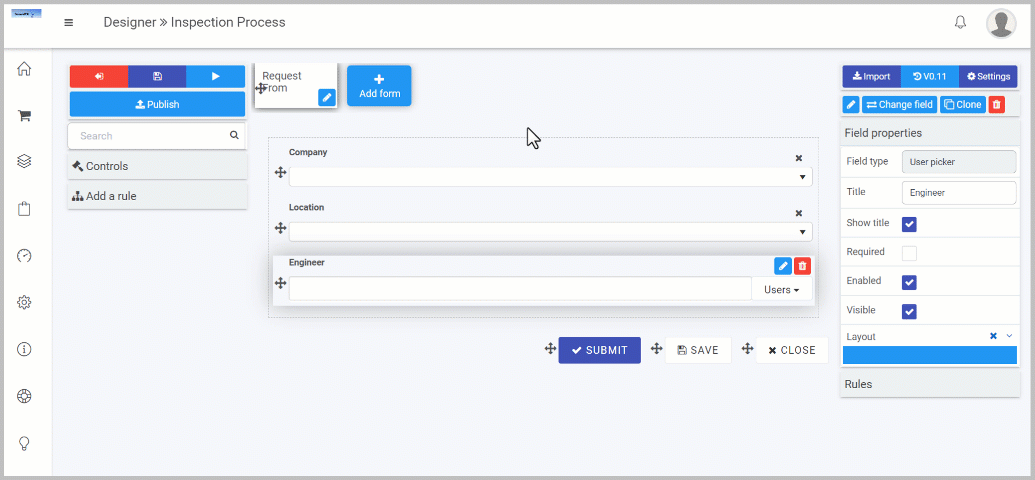
- Select the Engineer field so that the edit or pen icon
 appears. This means you are now in edit mode of the field.
appears. This means you are now in edit mode of the field. - Go to the Right-hand pane and click on Clone

- A Duplicate or move field dialog box appears. Click on the dropdown list and select Request form.
- Leave Move field instead checkbox unchecked and click OK.
- Select the Engineer copy field so that the edit or pen icon
 appears.
appears. - Click the edit or pen icon
 to edit the properties.
to edit the properties. - Change the Title to Safety Manager.
- Change Name (unique) to a unique identifier.
- Click OK to save changes.
Status field - text box
The Status field represents the current status of the whole process. We will make the status field invisible so we can track the inspection progress but not show it to the user. The Status field will be used in the dashboard at a later stage in this example.

- Click on Controls in the left-hand pane to expand the Controls menu.
- Select Input to view the range of Input controls.
- Click on Text box.
- Select the Text box 1 field so that the edit or pen icon
 appears.
appears. - Change the Title to “Status”.
- Change Name (unique) to a unique identifier.
- Click on **OK **to save the field.
- Select the Status field so that the edit or pen icon
 appears.
appears. - In the Right-hand pane, under Field properties click on the Visible checkbox to uncheck it. To learn more about field properties, go to Field properites.
Adding rules to Submit button
To take a look back at our requirements for our Request form, we need 2 rules for the Submit button.
- Set status to Requested - Sets the status field that we created to “Requested”.
- Send email to Engineer - Sends an email to the selected engineer from the Engineer field.
Creating a Set form field rule - Set status to Requested
With this rule we will be setting our Status field to “Requested”. We will be using the Set form field rule from the Data set of rules.
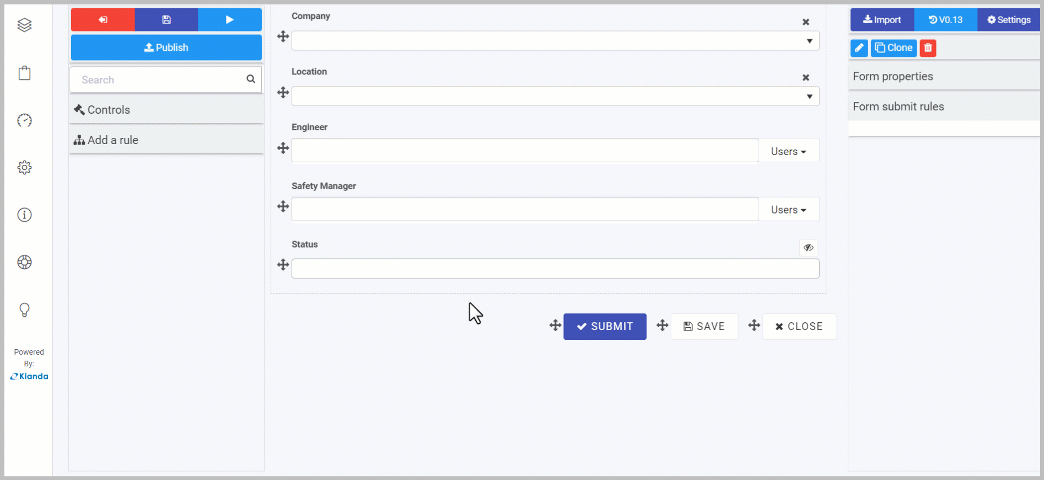
-
Select the Submit button by clicking on it so that the edit or pen icon
 appears.
appears. -
In the Left-hand pane click on Add a rule.
-
Click on Data.
-
Select Set form field.
-
In the Edit rule dialog box, change the Title to “Set status to Requested”
-
Click on Form field to set dropdown.
-
Under the Request Form select Status field.
-
In the Value or expression box, type Requested.

-
Click on OK button to save rule.
-
With the Submit button selected, in the Right-hand pane click on the Rules.
-
The Set status to Requested is under the Close rule. Drag and drop the Set status to Requested rule to the top of the list.
Creating a Send email rule - Send email to Engineer
This rule will be used to send an email to the selected Engineer. We will be using the Send email rule from the Communications set of rules. In this rule we will add expressions, to learn more go to Expressions.
-
Select the Submit button by clicking on it.
-
In the Left-hand pane click on the Add a rule tab.
-
Click on Communications.
-
Select Send email.
-
In the Edit rule box, change the Title to “Send email to Engineer”
-
Click on the person icon
 on the To: part of the email.
on the To: part of the email. -
In the Select email users box select the User(s) defined in a user field radio button.
-
In the Select a user field select Engineer.

-
Change the subject to New Inspection Request.
-
Change the body of the email to:
Hi, You are requested to visit ...... to complete an inspection for ...... Please ...... to view the Inspection Form. Regards, The Safety Team -
Adding Expressions:
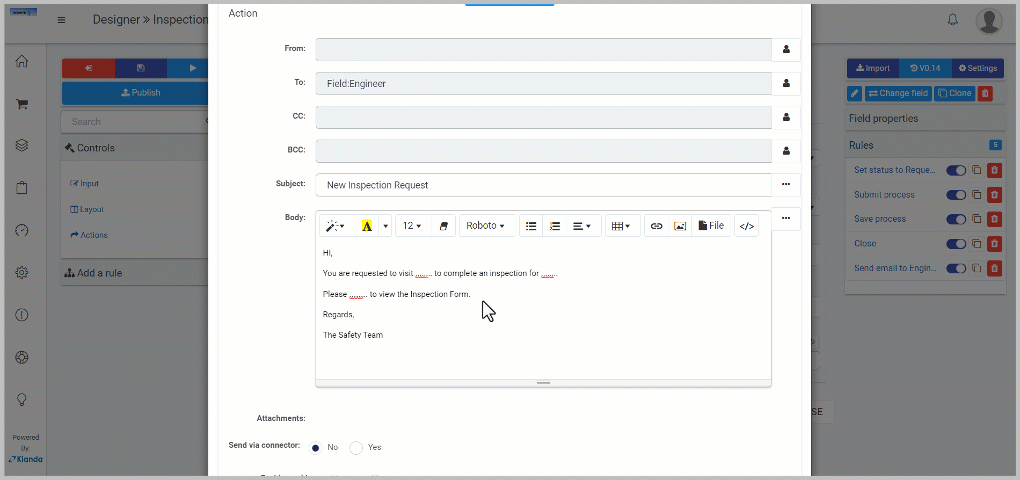
-
Location
- To add an Location click your cursor where you want to add it. In our case it is in the blank space between the words “visit” and “to”.
- Click on the 3 dots button
 on the the right-hand side of the Body box.
on the the right-hand side of the Body box. - Click on the Add field to expression and select Location from the dropdown list.
- Click on Add to expression
 The expression is added into the Expression window. Note that the expression is the unique identifier for that field.
The expression is added into the Expression window. Note that the expression is the unique identifier for that field. - Click on OK on the Expression builder dialog box.
-
Company
-
To add the Company expression, start off by clearing Add field to expression field and follow the steps above.
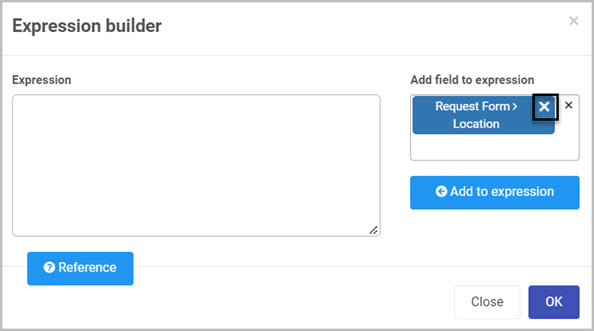
-
-
ProcessLink() - Links you to the open form of this process.
-
To add the ProcessLink() expression, click on the 3 dots button
 on the the right-hand side of the Body box.
on the the right-hand side of the Body box. -
Click on the Reference
 button.
button. -
From the Expression reference copy ProcessLink()
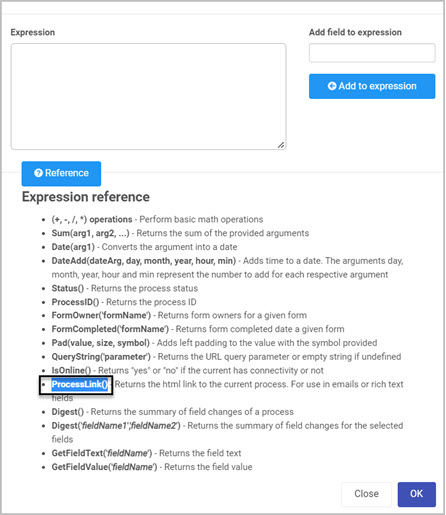
-
Click on Close on the Express builder dialog box to exit.
-
Paste in the ProcessLink() in between “Please” and “to” on the second line of the email.
-
In the parentheses of the ProcessLink() open up quotation marks and in between, type click here.
-
-
-
Click on OK in the Edit rule dialog box.
-
With the Submit button selected, in the Right-hand pane click on the Rules.
-
Send email to Engineer is located under the Close rule. Drag and drop the Send email to Engineer rule in between Submit process and Set status to Requested.
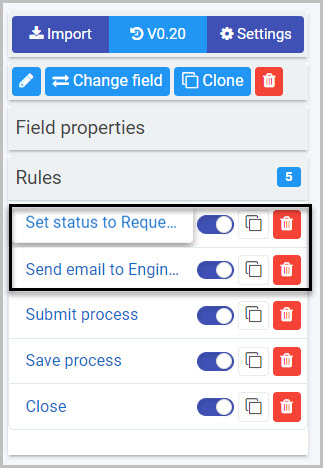
-
To save your changes to the form, click on the Save button

Request Form Summary
To summarise our Request From, we created all fields, buttons and rules that we stated in our requirements. Our Safety Managers can fill out our Request Form which automatically sends an email to an engineer stating what Location to visit and at what Company. We are also updating our Status field to keep track of the process.
What’s next 
To follow a step by step guide on creating our Inspection From, go to Creating Inspection Form.
2.2 - Inspection Form
Creating the Inspection Form
To begin this example of creating an Inspection Form, we need to add a new form to our process.
-
From the process creation page, click on Add form. This can be found at the top of your screen.

-
Title - Name to represent this form. In our case we will call it Inspection Form.
-
Name (unique) - A unique identifier for our form. You can give this any name you would like as long as it’s unique.
-
Default owner(s) - This field identifies which users can fill out our form when it’s complete. In our case we will choose from Groups and choose our Management Team. To learn more about how to create groups in Kianda go to creating groups.
-
Activate with - Means that the form can be activated with other forms within the process, so they can be edited at the same time. This means several forms become the current form in a form group. In our case we will leave this blank.
-
Submit mode - This option means that when a process instance is running you can choose only this form to be submitted, or you can choose all forms in edit mode meaning that several forms could have their details submitted or saved. Choose Only this form radio list.
-
Form icon - Dropdown field to select an icon for the form.
-
Form theme - This option is used to change the colour of the form tile, for example Green.
-
Enable quick actions - if you tick the checkbox, you can select from the options a) Enable re-assign b) Enable edit and c) Enable custom action. We will leave this box unchecked.
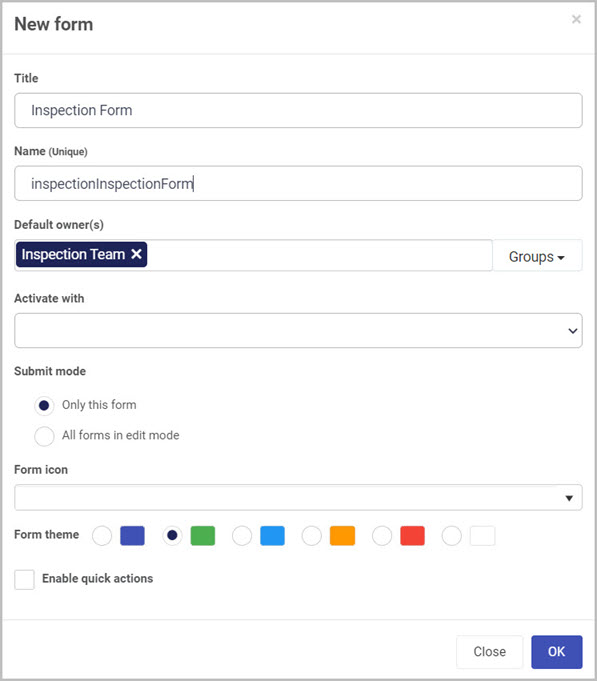
-
-
Click on the OK button when you are finished editing to save your changes or click on Close to exit the dialog box without saving.
-
To save your changes to the form, click on the Save button


Creating Form Fields
Taking a look back at our requirements, on the Inspection Form there is five different fields which will be used to complete an inspection along with five inner fields for our table:
- Date - Representing the day of the inspection.
- Inspection checklist - Checklist that will be filled out by an Engineer.
- Question - Question asking the engineer to make a check on the inspection.
- Pass or fail - Radio list with a yes or no indicating whether a check is passed or failed.
- Comment - Text box used by the engineer for any comments on a check.
- Upload file - Upload file button used to upload an image.
- Image - Image container that contains the uploaded image.
- Utility panel - An invisible to the user panel used to hold our word template and generated PDF file.
- Upload template - Word template used to create a PDF file.
- Generated PDF - File field to hold our generated PDF.
Creating a Date field - Date
The Date field represents the day, month and year of our inspection. To learn more about Date fields, go to Date Control.

-
To add a Data field, first select the Inspection Form so that the edit or pen icon
 appears.
appears. -
Click on Controls in the left-hand pane to expand the Controls menu.
-
Select Input to view the range of Input controls.
-
Click on Date.
-
Select the Date field so that the edit or pen icon
 appears.
appears. -
Click on the edit or pen icon
 to open the Edit field dialog box.
to open the Edit field dialog box.
-
Change the Title to Date.
-
Chane the Name (unique) to a unique identifier.
-
Click on OK on the Edit field dialog box.
Creating a Table field - Inspection Checklist
The Inspection Checklist will be used by an engineer to fill out. Inside of the table we need to have five different columns. First column will be a text box representing a check that our engineer must complete. Second column will be our passed radio list of Yes and No options. Third column is another text box for any comments that the engineer might have. Forth column is a File upload field to upload any images. Our last, fifth column is the Image container to hold the uploaded image. To learn more about Table input, go to Table control.
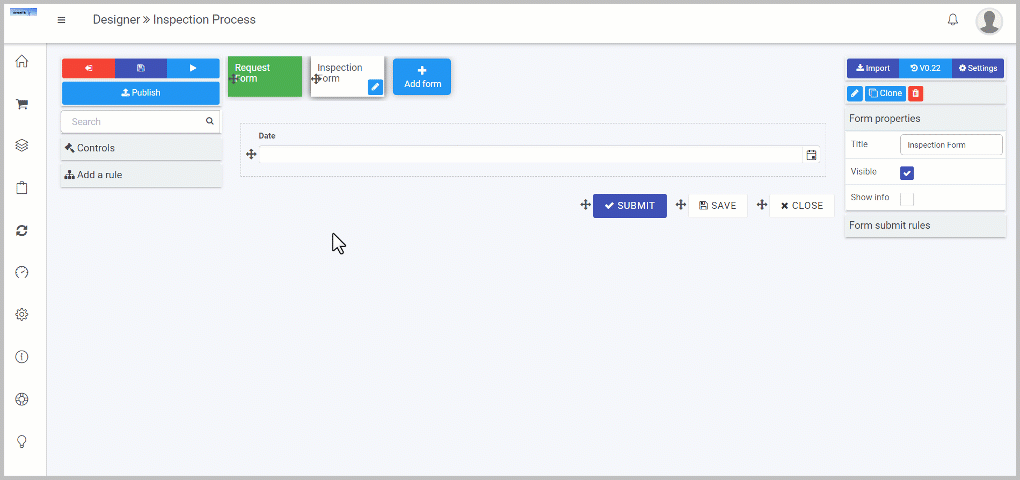
-
To add a Table field, first select the Inspection Form so that the edit or pen icon
 appears.
appears. -
Click on Controls in the left-hand pane to expand the Controls menu.
-
Select Input to view the range of Input controls.
-
Click on Table.
-
Select the Table field so that the edit or pen icon
 appears.
appears. -
Click on the edit or pen icon
 to open the Edit field dialog box.
to open the Edit field dialog box.
-
Change the Title to Inspection Checklist.
-
Chane the Name (unique) to a unique identifier.
-
Click on OK on the Edit field dialog box.
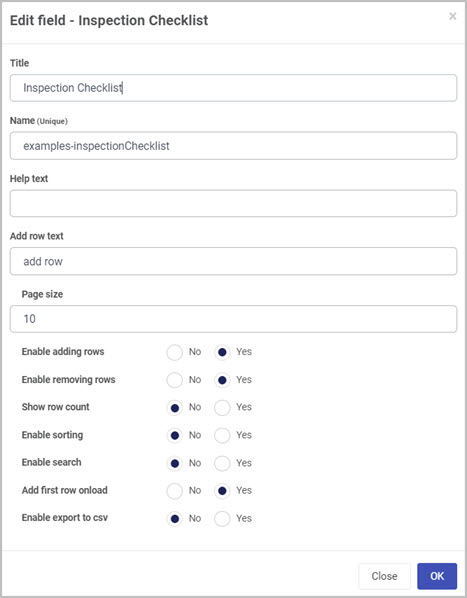
Changing the Table layout
When adding a table in Kianda, the table has two text boxes inside by default. We will leave them in as we’ll be using them for our Question and Comment fields.
Changing Text box field - Question
The Question field represents what kind of check the engineer must complete. This field will be disabled so that the users of this form will not be able to change the contents of the question.
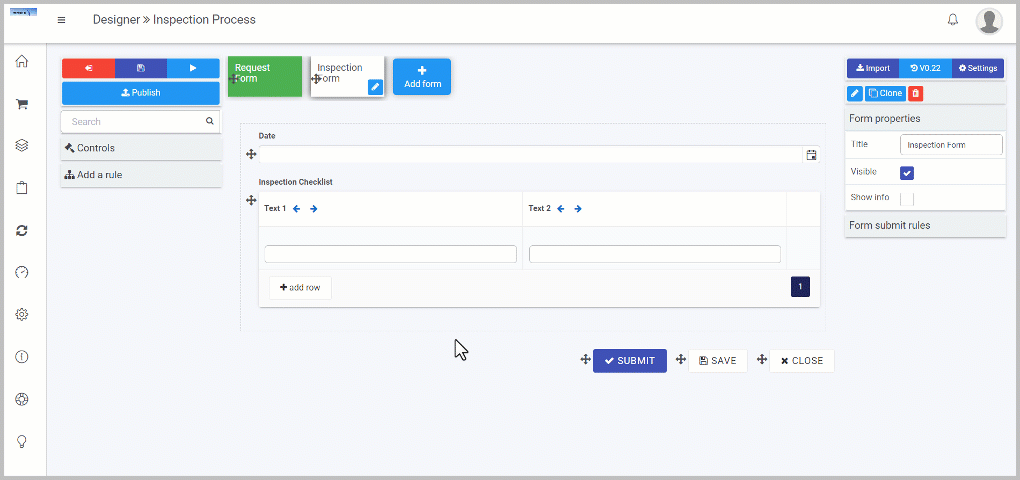
-
Click on the left text box inside of the table so that the edit or pen icon
 appears.
appears.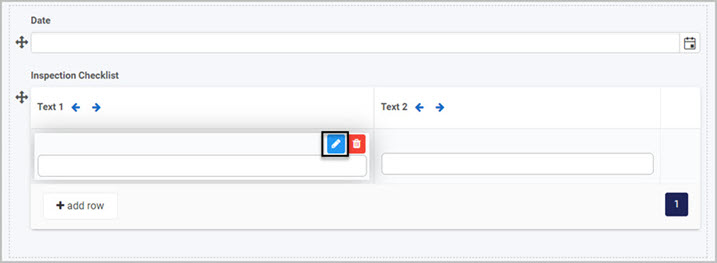
-
Click on the edit or pen icon
 to open the Edit field dialog box.
to open the Edit field dialog box. -
Change the Title to Question.
-
Chane the Name (unique) to a unique identifier.
-
Click on OK on the Edit field dialog box.
-
Click on Field properties in the right-hand pane.
-
Click on the Enabled checkbox to uncheck it.

Adding Radio List to a table - Passed field
The Radio list is a List type from the Input set of fields. We will enter the options manually and set the field to be of type radio. To find out more about radio lists, go to List Control.
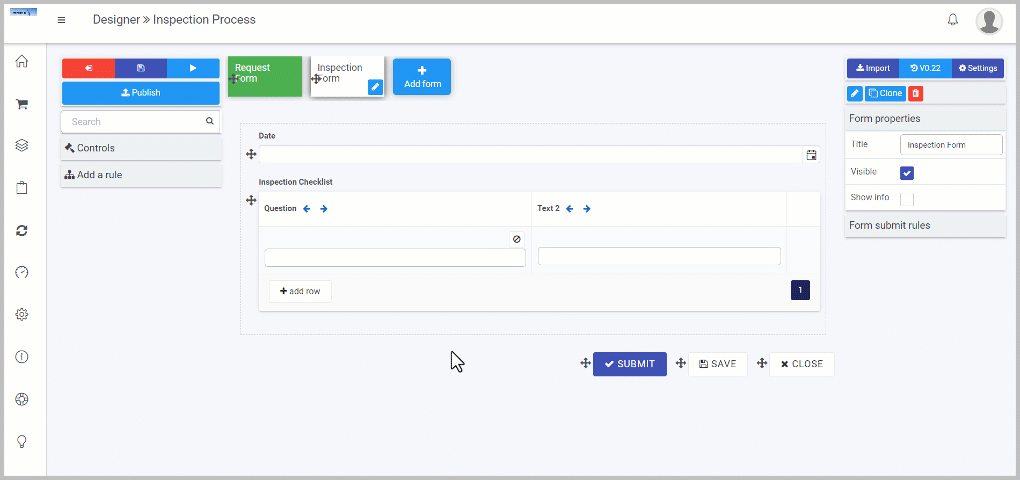
-
To add a Radio list, first select the Question field in the checklist table so that the edit or pen icon
 appears.
appears. -
Click on Controls in the left-hand pane to expand the Controls menu.
-
Select Input to view the range of Input controls.
-
Click on List.
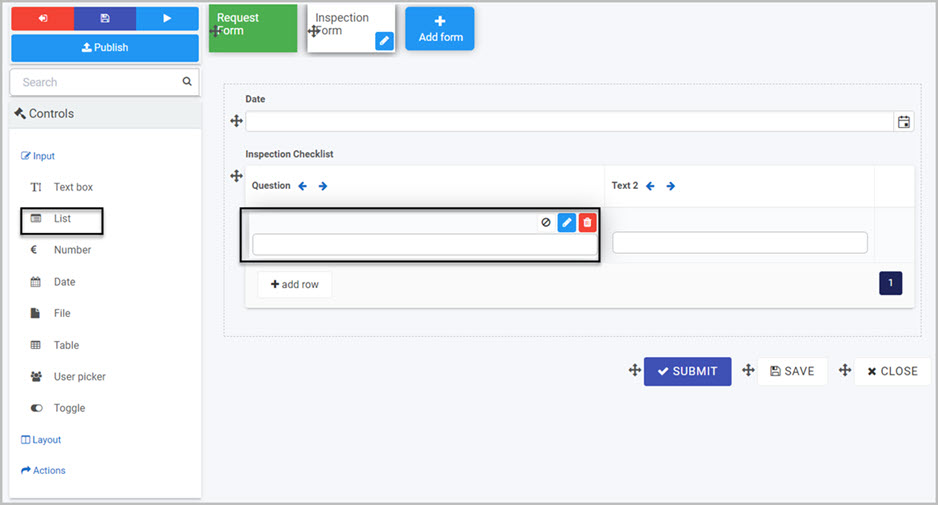
-
In the New field - List dialog box, change the Title to Passed.
-
Select Entered manually in the List source options.
-
Type in Yes and No in the text box as shown in the image below.
-
Select Radio list from the Display format options.
-
Select Vertical in the List display position.

-
Click on OK on the Edit field dialog box.
The image below shows how the Inspection Checklist should look so far. You can move the table fields with the left and right arrows above each field. Note the crossed circle above the question text box, this indicated that this field is disabled and will not be editable by an user of the form.

Changing Text box field - Comment
The Comment field gives the ability to type in a comment on any of the checks performed by the engineer. We will use the Text 2 field which is automatically created in when adding the Table field.

-
Click on the right Text 2 inside of the table so that the edit or pen icon
 appears.
appears.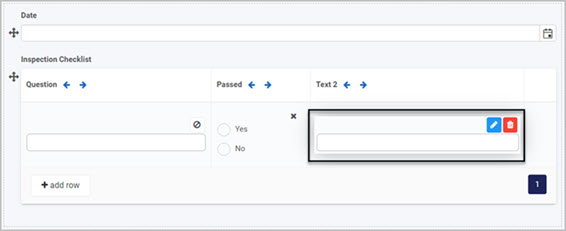
-
Click on the edit or pen icon
 to open the Edit field dialog box.
to open the Edit field dialog box. -
Change the Title to Comment.
-
Chane the Name (unique) to a unique identifier.
-
In the Mode options, select Multiple lines of text. Selecting Multiple lines of text adds another option called Rows. To learn more about text box options, go to Text box control.
-
Click on the Rows option and type “3” or use the up arrow to increase and down arrow to decrease.

-
Click on OK on the Edit field dialog box.
Adding a File field - Upload Image
The Upload Image field allows the engineer to upload an image into our form and into a specific check within the checklist. From the File options, we need to save the uploaded file in our database, for example SharePoint, this database needs to be pre-created. To learn more about File input go to File upload control.
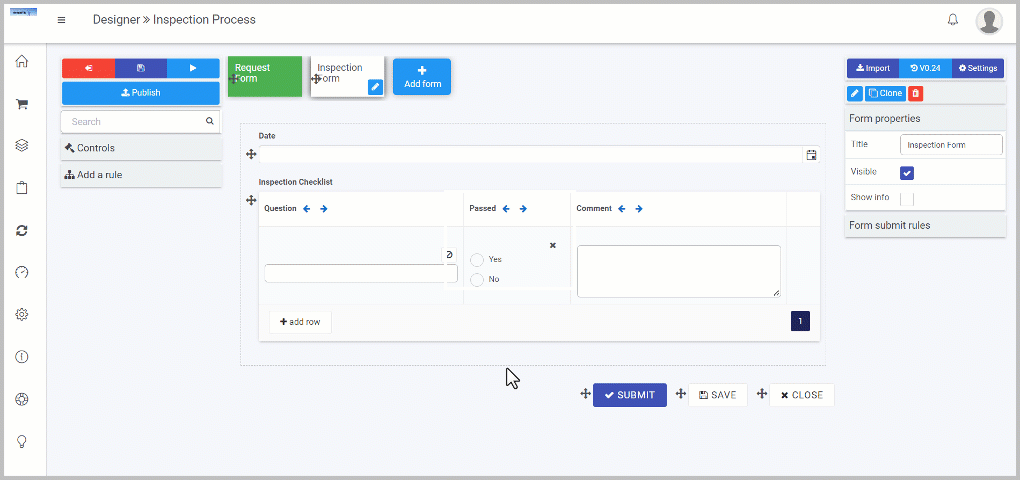
-
To add a File field, first select the Comment field in the checklist table so that the edit or pen icon
 appears.
appears. -
Click on Controls in the left-hand pane to expand the Controls menu.
-
Select Input to view the range of Input controls.
-
Click on File.
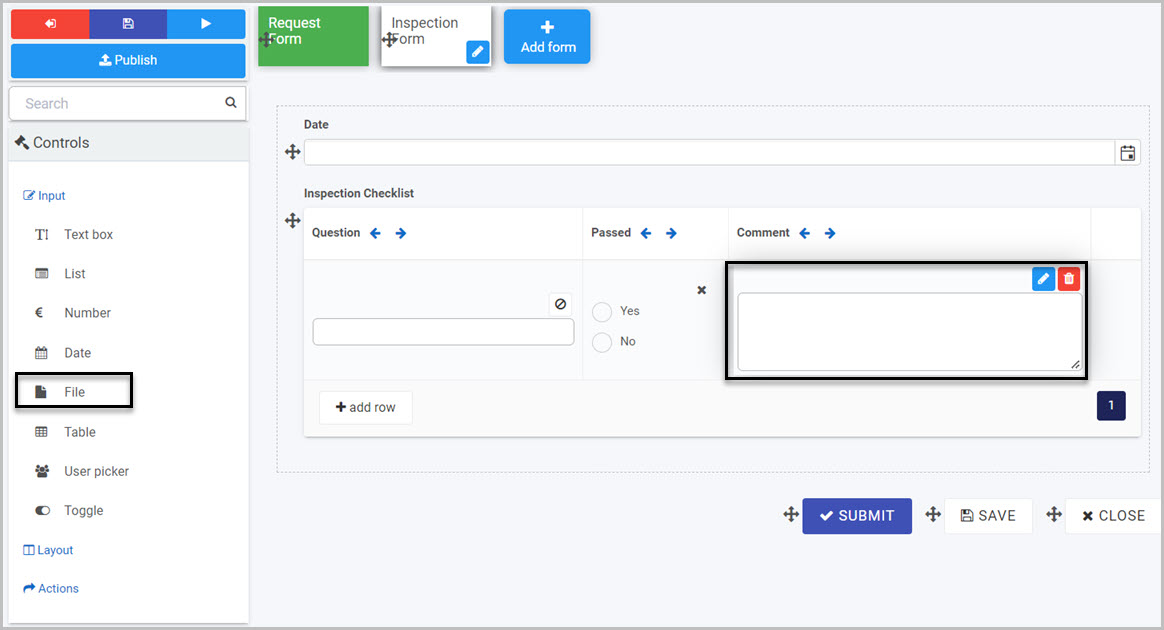
-
Change the Title to Upload Image.
-
Chane the Name (unique) to a unique identifier.
-
Click on Destination
 to open datasource dialog box.
to open datasource dialog box. -
Select your desired location to save the file.
-
Click on OK on the Datasource dialog box.
-
With the Allow file override option you can choose whether or not to allow file override. If you choose ‘Yes’, if a user goes back into the form and uploads another file to the File upload field, this will override the original file they had uploaded. This option works in conjunction with the Allow uploading multiple files option - if you choose to allow multiple files to be uploaded, then the ‘Allow file override’ option is no longer relevant (as uploading more files will not override file/files already uploaded). We will choose Yes for our process.
-
With the Enable media capture if you choose Yes, this enables the user to capture media to upload - on a mobile device, when the user clicks on the Upload button their camera/video recorder will open (depending on whether you’ve selected the file extension to be image or video). We will choose Yes for our process.
-
Button icon by default, the file upload icon is
 but you can change this by clicking the Button icon drop-down menu and choosing a different icon from the large range of icons available. We will choose a camera icon for our process.
but you can change this by clicking the Button icon drop-down menu and choosing a different icon from the large range of icons available. We will choose a camera icon for our process. -
Click on OK on the New field - File dialog box.
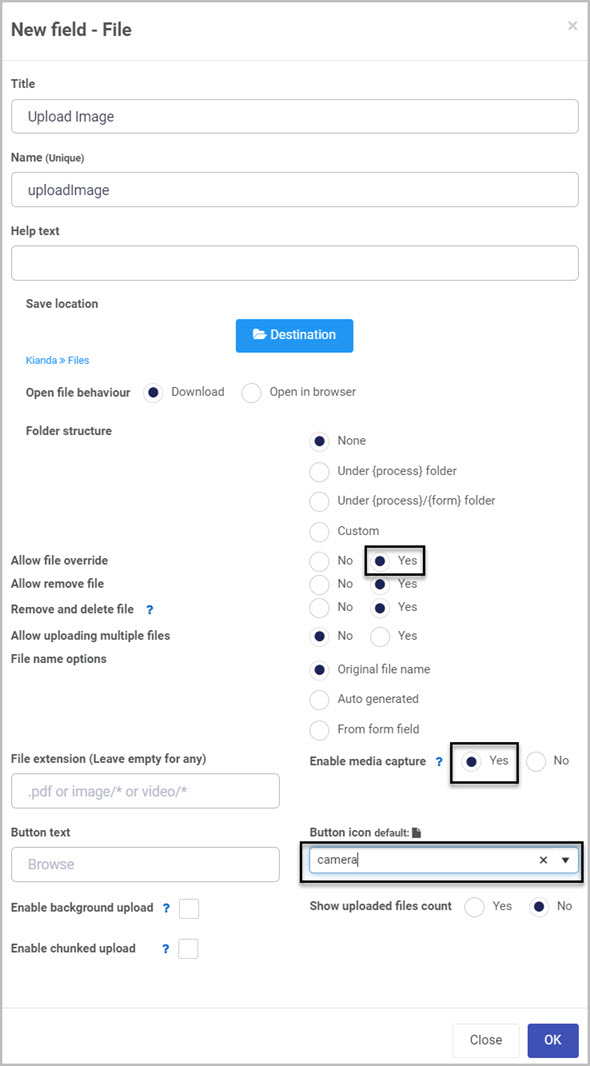
Adding an Image field - Image
The Image field is used for holding an image. In our case we will use this field to hold the image that is uploaded by the engineer during the inspection. To learn more about Image fields, go to Image control.
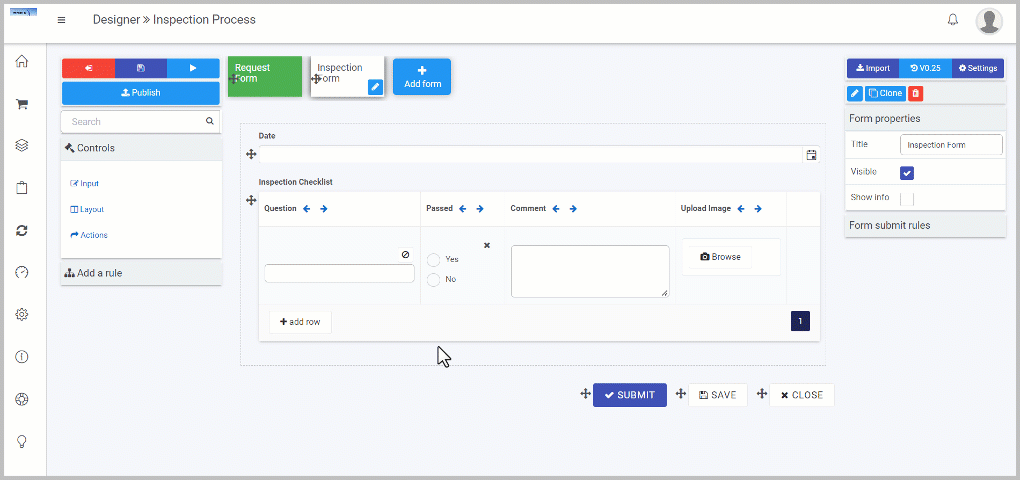
-
To add an Image field, first select the Upload Image field in the checklist table so that the edit or pen icon
 appears.
appears. -
Click on Controls in the left-hand pane to expand the Controls menu.
-
Select Actions to view the range of Action controls.
-
Click on Image.
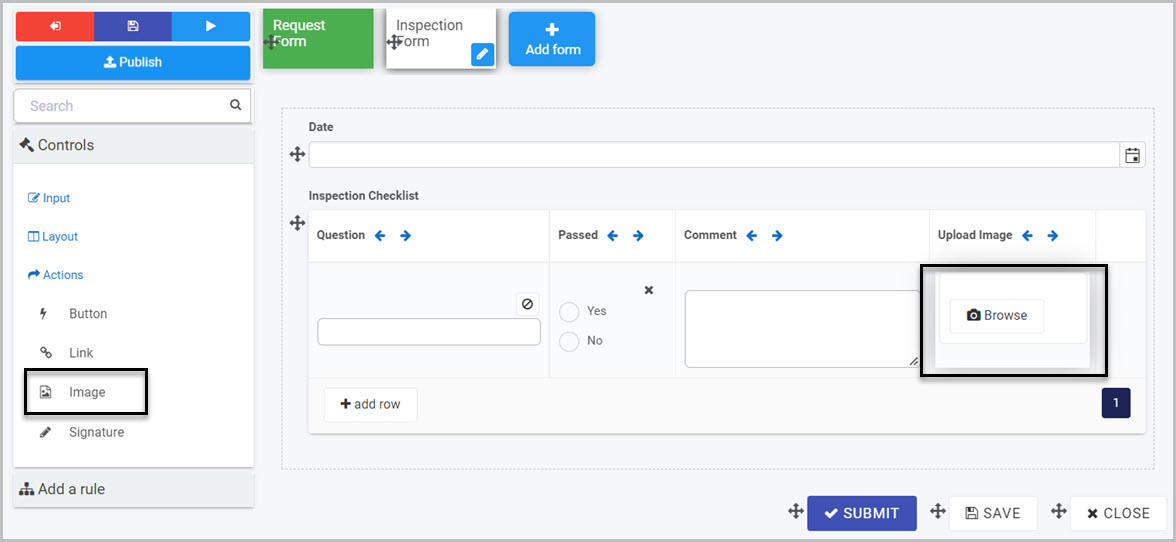
-
Change the Title to Upload Image.
-
Chane the Name (unique) to a unique identifier.
-
Select File field from the Image source option, from the Inspection Form drill down and select Upload Image.
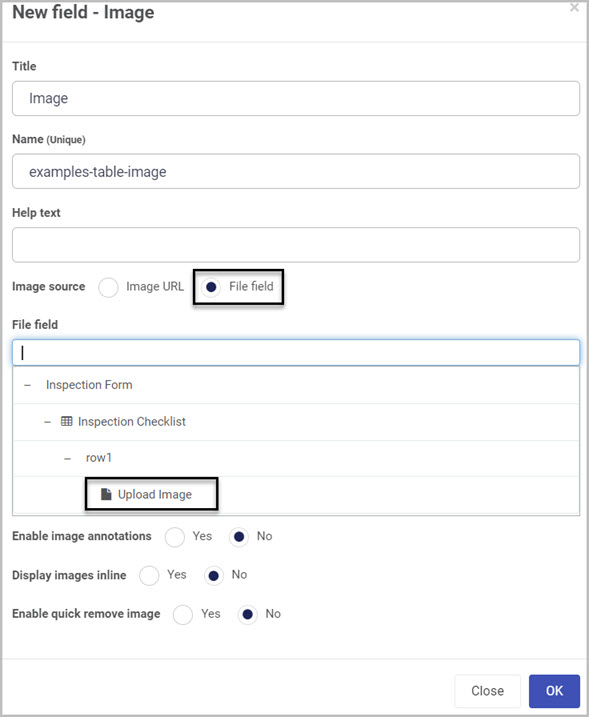
-
In the Image max height and Image max width type in 100.
-
Click on OK on the New field - Image dialog box.
Adding rows to Table - Checklist
We have now created all fields needed for our Inspection Checklist. The First row we created is a template for all other rows and will NOT be visible and editable by a user of the form. To learn more about Tables, go to Table control. In our Table we will have three different checks that we need our engineer to complete therefore we will add three rows.
-
To add a row click on Add Row.
-
Repeat step 1 two more times to have three rows. You can delete a row by clicking the red trash
 on the right-hand side of the row.
on the right-hand side of the row.
-
In the First row of the Question field type in Are there adequate safety warnings?
-
In the **Second **row of the Question field type in Are the rotors in motion? in the Question field.
-
In the Third row of the Question field type in Does the tower pass a visual inspection? in the Question field.

Disabling row adding and removing
For our Inspection Form we will disable row adding and row removing from the Checklist. This will prevent the engineer to add and remove rows from the checklist when he is completing the inspection.
-
Select the Table so that the edit or pen icon
 appears.
appears. -
Click on the edit or pen icon
 to edit the Table.
to edit the Table. -
Select No on the Enable adding rows option.
-
Select No on the Enable removing rows option.
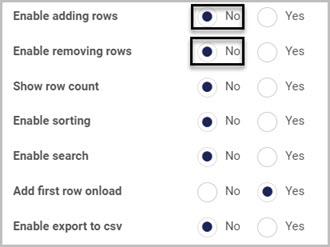
-
Click on OK on the Edit field dialog box.
Creating a Utility panel
The utility panel will hold our word document template and the generated PDF file of our inspection. First we need to create a utility panel and make it invisible to the user. Utility panels are useful in processes as they can act as containers for information or data that are used with in a process but not seen by other users.
Adding a Panel field
-
To add a Panel field, first select the Inspection Form so that the edit or pen icon
 appears.
appears. -
Click on Controls in the left-hand pane to expand the Controls menu.
-
Select Layout to view the range of Layout controls.
-
Click on Panel.
-
Select the Panel field so that the edit or pen icon
 appears.
appears. -
Click on Field properties in the right-hand pane.
-
Click on the Visible checkbox to uncheck it.
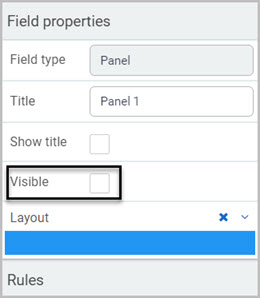
-
Click on the edit or pen icon
 to edit the Panel.
to edit the Panel. -
Change the Title to Utility panel.
-
Chane the Name (unique) to a unique identifier.
-
Click on OK on the Edit field dialog box.
Adding a File field - Upload template
The Upload template is a File field. This field will be used to upload a word document which will be the template for creating the PDF file.
-
To add a File field into the Panel, first select the Panel field so that the edit or pen icon
 appears.
appears.
-
Click on Controls in the left-hand pane to expand the Controls menu.
-
Select Input to view the range of Input controls.
-
Click on File.
-
Change the Title to Upload template.
-
Chane the Name (unique) to a unique identifier.
-
Click on Destination
 to open datasource dialog box.
to open datasource dialog box. -
Select your desired location to save the file.
-
Click on OK on the Datasource dialog box.
-
Click on OK on the Edit field dialog box.
Adding a File field - Generated PDF
The Generated PDF file is a File field which is used to hold our PDF from the above template.
-
To add a File field into the Panel follow steps 1 through 4 in the above Adding a file - Upload template section.

-
Change the Title to Generated PDF.
-
Chane the Name (unique) to a unique identifier.
-
Click on Destination
 to open datasource dialog box.
to open datasource dialog box. -
Select your desired location to save the file.
-
Click on OK on the Datasource dialog box.
-
Click on OK on the Edit field dialog box.
Creating a Word template
You can generate reports within Kianda processes and populate the reports with data captured within each process instance. We will be generating a PDF file for inspection reports where a report template can be used to show the information the engineer input to a Kianda form during his inspection. Each time an inspection is performed, a report is generated based on a Word template and the report shows the relevant information that was captured during that particular inspection.
To learn more on how to create the Word template using Kianda Add-in in Word go to Kianda Add-in to watch a short video going through the process step by step. Alternatively you can also go through the steps of learning the process by going to Word document add-in.
Adding rules to Submit button
To take a look back at our requirements for our Inspection form, we need 3 rules for the Submit button.
- Set status to Complete - Sets the status field that we created to “Complete”.
- Generate a PDF using word template - Generates a PDF file using a word template which we created using the Kianda Add-in.
- Send email to Safety Manager - Sends an email to the selected user from the Safety Manager field from our Request form.
Creating a Set form field rule - Set status to Completed
With this rule we will be setting our Status field to “Completed”. We will be using the Set form field rule from the Data set of rules.
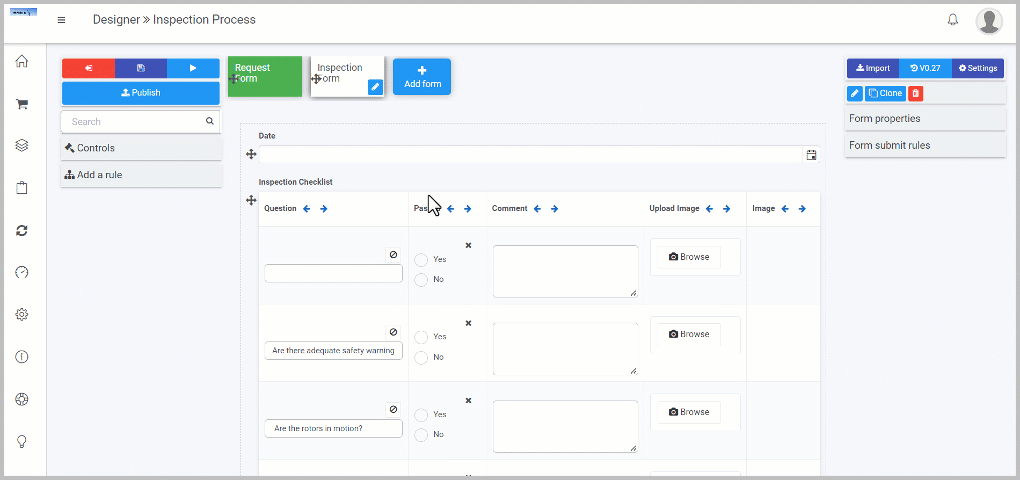
-
Select the Submit button by clicking on it so that the edit or pen icon
 appears.
appears. -
In the Left-hand pane click on Add a rule.
-
Click on Data.
-
Select Set form field.
-
In the Edit rule dialog box, change the Title to “Set status to Completed”
-
Click on Form field to set dropdown.
-
Under the Request Form select Status field.
-
In the Value or expression box, type Completed.

-
Click on OK button to save rule.
-
With the Submit button selected, in the Right-hand pane click on the Rules.
-
The Set status to Completed is under the Close rule. Drag and drop the Set status to Completed rule to the top of the list.
Creating a Generate word document rule - Generate PDF using word template
-
Select the Submit button by clicking on it so that the edit or pen icon
 appears.
appears. -
In the Left-hand pane click on Add a rule.
-
Click on File Management.
-
Select Generate word document.
-
In the Edit rule dialog box, change the Title to “Generate PDF using word template”
-
In the Select document template option, select Upload template field.
-
In the Select document destination option, select Generated PDF field.
-
In the Upload template file, brows for the created word template file.
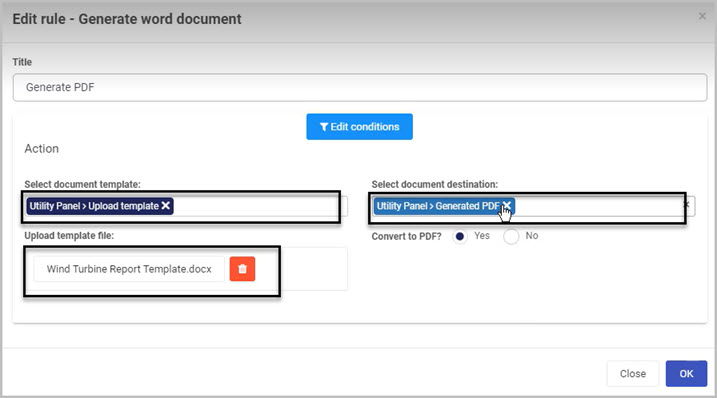
-
Click on OK in the Edit rule dialog box.
-
Move the Generate PDF using word template rule under the Set status to Completed rule.
Creating a Send email rule - Send email to Safety Manager
This rule will be used to send an email to the selected Safety Manager. We will be using the Send email rule from the Communications set of rules. In this rule we will add expressions, to learn more go to Expressions.
-
Select the Submit button by clicking on it so that the edit or pen icon
 appears.
appears. -
In the Left-hand pane click on the Add a rule tab.
-
Click on Communications.
-
Select Send email.
-
In the Edit rule box, change the Title to “Send email to Safety Manager”
-
Click on the person icon
 on the To: part of the email.
on the To: part of the email. -
In the Select email users box select the User(s) defined in a user field radio button.
-
In the Select a user field select Safety Manager from the Request form.

-
To attach the created PDF file to the email, click on File icon in the Body of the email.
-
In the Attach file to email dialog box, drill down and choose Generated PDF from the Inspection Form.

-
Change the body of the email to:
Hi, See report attached Regards, The Safety Team -
Click on OK on the Edit rule dialog box.
-
Move the Send email to Safety Manager rule under the Generate PDF using word template rule.
-
To save your changes to the form, click on the Save button

Inspection Form Summary
To summarise our Inspection From, we created all fields, buttons and rules that we stated in our requirements. Our Engineer can fill out our Inspection Checklist and submit the form which automatically sends an email to an Safety Manager with the generated PDF file of the report. We are also updating our Status field to Completed.
What’s next 
To follow a step by step guide on creating our Inspection From, go to Creating Dashboard.
2.3 - Dashboard
Kianda dashboards deliver a convenient way to provide insights into how your business processes are performing. Kianda dashboards offer easy reporting, permissions management, quick build, condition-based filtering and many more features.
From lists to tiles, filter and charts, dashboards allow you to build full digital experiences to monitor your real-time processes in a few minutes. To learn more about dashboards go to Dashboard pages.
Creating a Dashboard
-
In the left-hand side menu click on Home.
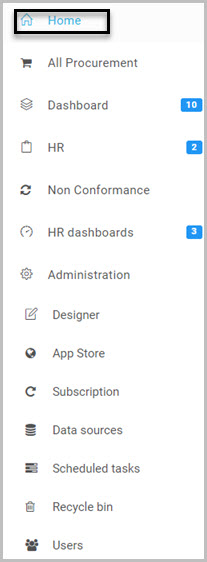
-
On the top right-hand side menu click on the plus
 to add a dashboard.
to add a dashboard. -
Change the Title to Inspection Dashboard.
-
Click on OK on the Create dashboard page dialog box.
-
Creating the Inspection dashboard will automatically bring you to a blank dashboard creation page.
Creating a List Widget
In this example we will use a List widget to keep track of all instances of our Inspection Processes. We will add the Status field from the Request From to the list to keep track in what stage is a particular process.
-
On the dashboard creation page, click on List in the top menu.

-
In the Add widget dialog box, change the Title to Inspection records.
-
List widget automatically shows all records of all our processes in the system. We need to select the Inspection Process. Click on the pen icon on the Inspection Records.

-
In the Edit List dialog box, select Inspection Process in the Business process option.
-
On the right-hand side of the Edit List dialog box click on Design Fields.
-
Select Status field from the Request Form.
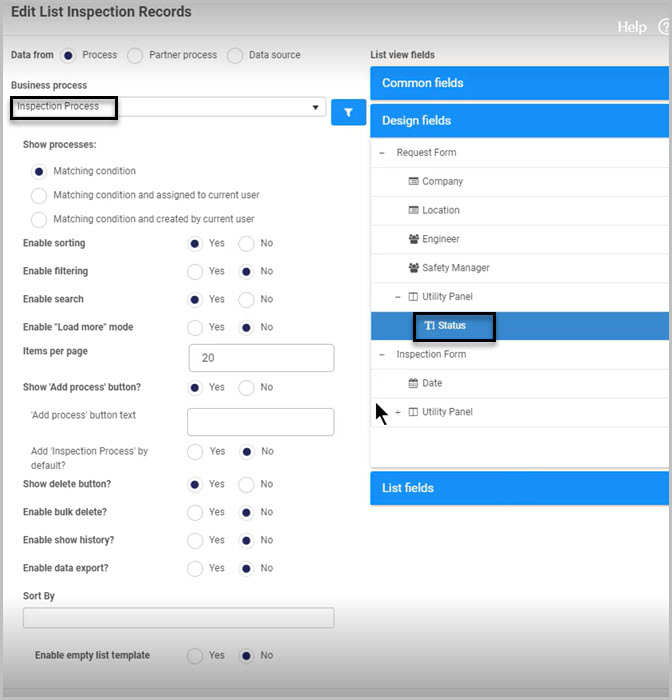
-
Click on OK in the Edit List dialog box to save changes.
Creating a Link widget
In this example we will use the Link widget in our dashboard. By clicking on it, our users will be able to create new instances of the Inspection Process starting in the Request Form. To learn more about Link widgets go to Link widget
-
On the dashboard creation page, click on List in the top menu.

-
In the Add widget dialog box, change the Title to Request an Inspection.
-
Click on OK in the Add widget dialog box.
-
We need to activate which process to start when clicking on the link, click on the pen icon to edit the Link widget

-
Click on Start New Process in the Edit button links dialog box.
-
In the Edit buttons links Request an Inspection dialog box select Inspection Process in the Target process option.
-
Click on OK in the Edit Link dialog box.
-
Click on OK in the Edit buttons links Request an Inspection dialog box.
Creating a Pie Chart widget - Pie chart
In this example we will use the Chart widget in our dashboard. We will create a pie chart from the available options, representing the status of our inspection processes. To learn more about Chart widgets go to Chart widget.
-
On the dashboard creation page, click on Chart in the top menu.

-
In the Add widget dialog box, change the Title to Inspection Status.
-
Click on OK in the Add widget dialog box.
-
We need to attach a process to the pie chart, click on the pen icon on the chart widget to edit it.
-
Select Inspection process in the Business process option.
-
Select Pie chart from the Chart type option.
-
Select Status field from the Label field option.
-
Click on OK in the Edit chart dialog box.
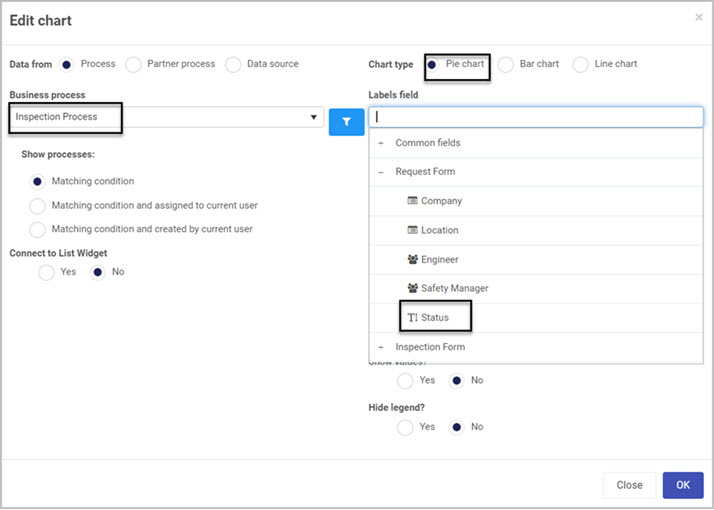
-
In the top right-hand menu click on
 to save your dashboard.
to save your dashboard.
Inspection Process Dashboard Summary
We have now created the dashboard for our Inspection process. Using the List widget, we can see all details of all instances of each inspection process that was created. By picking the Status field to show in our List widget, we can see which processes are Completed and Requested. With the Link widget we are allowing the users of the dash board to click on the link to start an Inspection process. Take a look at the finished dashboard for the Inspection Process below.
